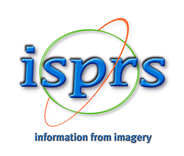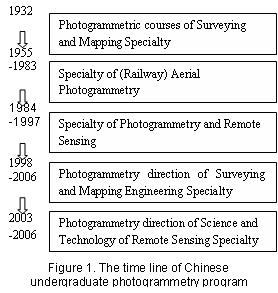|
The Photogrammetry Education ZHU Qing: Member of the Scientific Program Committee, ISPRS 2008 BeiJing, ABSTRACT After briefly review on the history of photogrammetry education in P.R.China, the development of undergraduate and graduate program, the corresponding curricula design are analyzed by using the data from Wuhan University in which the photogrammetry is awarded as the state-level key discipline. The academic educational program of photogrammetry in universities has trained students to perform tasks in all fields of the photogrammetric profession. In recent years, the nature of photogrammetry is changing and multidisciplinary geomatics are developing very rapidly, the educational program of photogrammetry has also been changed in new concepts and structures to adapt such new technologies and the extension of the field. Finally, the prospect of photogrammetry education for the requirements of multidisciplinary geomatics is proposed. The growing interest in fast and accurate 3D spatial data collection (such as city modeling and digital earth) results in the increasing need of photogrammetry as principal tool, photogrammetric courses are therefore requested to be up to date and to become one kind of the fundamental professional courses for university geomatics and remote sensing degree programs. KEY WORDS: Photogrammetry, Education, Remote Sensing, Geomatics, China 1. INTRODUCTION The word photogrammetry comes from Greek words photos (meaning "light"), gramma (meaning that which is drawn or written) and metron (meaning "to measure"). It originally signified measuring graphically by means of light (Whitmore and Thompson, 1966).
Table 1. The characteristics of the three stages of photogrammetry
2. PHOTOGRAMMETRY DEGREE EDUCATION 2.1 Undergraduate and graduate program Figure 2. Recruit undergraduates number of Wuhan University
Figure 4. Recruit Ph.D. graduates number of Wuhan University
Table 2. German job market for surveyors
Figure 5. The research themes for M.Sc. and Ph.D. graduates in photogrammetry and remote sensing 2.2 Curriculum development According to the undergraduate program in photogrammetry of Wuhan University, there are five different layers of courses as listed in Table 3. From 1996 to 2005, there are obvious curricula changes in the photogrammetry program as the specialty changed from photogrammetry and remote sensing to science and technology of remote sensing.
Table 3. Part curricula description of photogrammetry undergraduate program
Table 4. Credit hours distribution for 2004
As we know, the implementation of good education program and curricula design greatly depends on quality teaching resources, such as the teachers' level of knowledge and ability, the text books, the teaching methodology and laboratory. In Wuhan University and Information Engineering University, the course content covers the entire photogrammetry field and full 3 degree structures (B.Sc., M.Sc., and Ph.D.) based on their perfect faculty and other teaching resources, but the emphasis of certain aspects of the discipline differs from university to university as shown in Table 5 and Table 6.
Table 5. University education resources for photogrammetry
Table 6. Emphasis of Chinese photogrammetry programs In the decade, as one of the Chinese economic development achievements, all the university facilities, such as the classroom and laboratory, the teaching methods and devices, have been greatly improved. Based on the multi-media and network technologies, computer aided education becomes the important part of photogrammetry education all over the country. It is very popular to use the DPWs, various remote sensed image processing softwares, as well as GIS softwares for teaching and research purpose. 2.4 International cooperation The international academic cooperation and exchange in photogrammetry education are very active in China. We have signed many agreements on cooperation with governments or universities all over the world. More and more teachers and students have the experiences of oversea study and / or research. Especially, in recent years the joint M.Sc. and Ph.D. programs in photogrammetry or geospatial information science have been carried out among Chinese universities and foreign universities, such as, the ITC (International Institute for Geo-Information Science and Earth Observation) of Netherlands, the Stuttgart University of Germany, AIT (Asian Institute of Technology) of Thailand, and so on. At the same time, increasing world-known photogrammetrists become the guest professor or honorary professor of Chinese universities, and are invited to China to give presentations or lectures every year. Under the umbrella of training section of national remote sensing center, since 1988 the foreign students have been trained in Wuhan University each year for the outer space committee of UN and Asia Pacific Economy and Society Council. At present, even in Wuhan University, there are more and more oversea students studying for M.Sc. or Ph.D. degrees in photogrammetry. 3. PROSPECT OF PHOTOGRAMMETRY EDUCATION
4. CONCLUDING REMARKS We have seen that digital photogrammetry has become the pervasive technology in modern mapping. we can expect significant progress in the next few years. ACKNOWLEDGEMENTS I'd like to acknowledge the contributions of many people who have provided information about Chinese photogrammetry education, this paper is also benefited from their comments and suggestions. Last but not least: thanks to Prof. LI Deren, Prof. XU Qing, Prof. QI Hua, Prof. JIANG Yan, Prof. TONG Xiaohua, Prof. LIU Qingyuan, prof. DU Peijun, Prof. SONG Weidong, Miss WEN Lin and Miss XU Min. REFERENCES
|
|||||||||||||||||||||||||||||||||||||||||||||||||||||||||||||||||||||||||||||||||||||||||||||||||||||||||||||||||||||||||||||||||||||||||||||||
|
|
|||||||||||||||||||||||||||||||||||||||||||||||||||||||||||||||||||||||||||||||||||||||||||||||||||||||||||||||||||||||||||||||||||||||||||||||

 In 1932, the photogrammetry was firstly included as one of the major courses in the department of Surveying and Mapping, Tongji University, Shanghai, China. In 1952, the specialty of aerophotogrammetry was established in Tongji University. In 1956, the then Wuhan Technical University of Surveying and Mapping (now merged into the Wuhan University) was founded based on the collection of related specialities in Tongji University, Tianjing University, Tsinghua University, Nanjin Institute of Technology, South China Institute of Technology and Qiangdao Institute of Technology, and the specialty of aerophotogrammetry was set up in 1957. Almost during the same period, similar specialty is set up in the then Zhengzhou Institute of Surveying and Mapping (now Information Engineering University) and the then Tangshan Railway College (now Southwestern Jiaotong University) respectively (Li et al., 1987). With the development of remote sensing technology, the specialty of aerophotogrammetry was reformed as Photogrammetry and Remote Sensing in 1984. At present it is well-known that the photogrammetry is a part of remote sensing, which involves viewing objects stereoscopically to make accurate measurements. As an independent branch, photogrammetry and remote sensing becomes one of the most active and evolving fields in China. From 1984 to 1998, the Chinese photogrammetry education possessed its golden time. The past development of Chinese surveying and mapping discipline was referred to the specialty subdivision mode of Soviet Union, which plays important role in the planned economy of China (Ning, 2003).
In 1932, the photogrammetry was firstly included as one of the major courses in the department of Surveying and Mapping, Tongji University, Shanghai, China. In 1952, the specialty of aerophotogrammetry was established in Tongji University. In 1956, the then Wuhan Technical University of Surveying and Mapping (now merged into the Wuhan University) was founded based on the collection of related specialities in Tongji University, Tianjing University, Tsinghua University, Nanjin Institute of Technology, South China Institute of Technology and Qiangdao Institute of Technology, and the specialty of aerophotogrammetry was set up in 1957. Almost during the same period, similar specialty is set up in the then Zhengzhou Institute of Surveying and Mapping (now Information Engineering University) and the then Tangshan Railway College (now Southwestern Jiaotong University) respectively (Li et al., 1987). With the development of remote sensing technology, the specialty of aerophotogrammetry was reformed as Photogrammetry and Remote Sensing in 1984. At present it is well-known that the photogrammetry is a part of remote sensing, which involves viewing objects stereoscopically to make accurate measurements. As an independent branch, photogrammetry and remote sensing becomes one of the most active and evolving fields in China. From 1984 to 1998, the Chinese photogrammetry education possessed its golden time. The past development of Chinese surveying and mapping discipline was referred to the specialty subdivision mode of Soviet Union, which plays important role in the planned economy of China (Ning, 2003).


